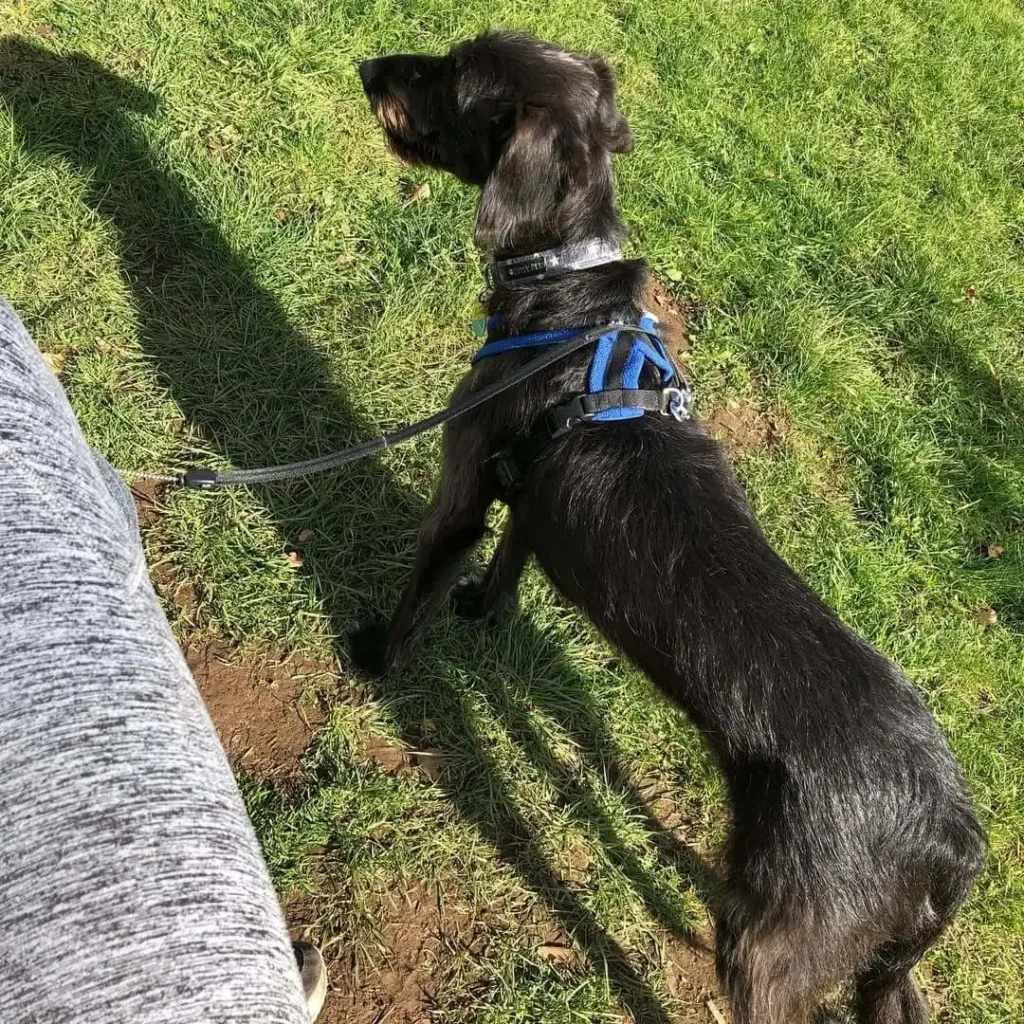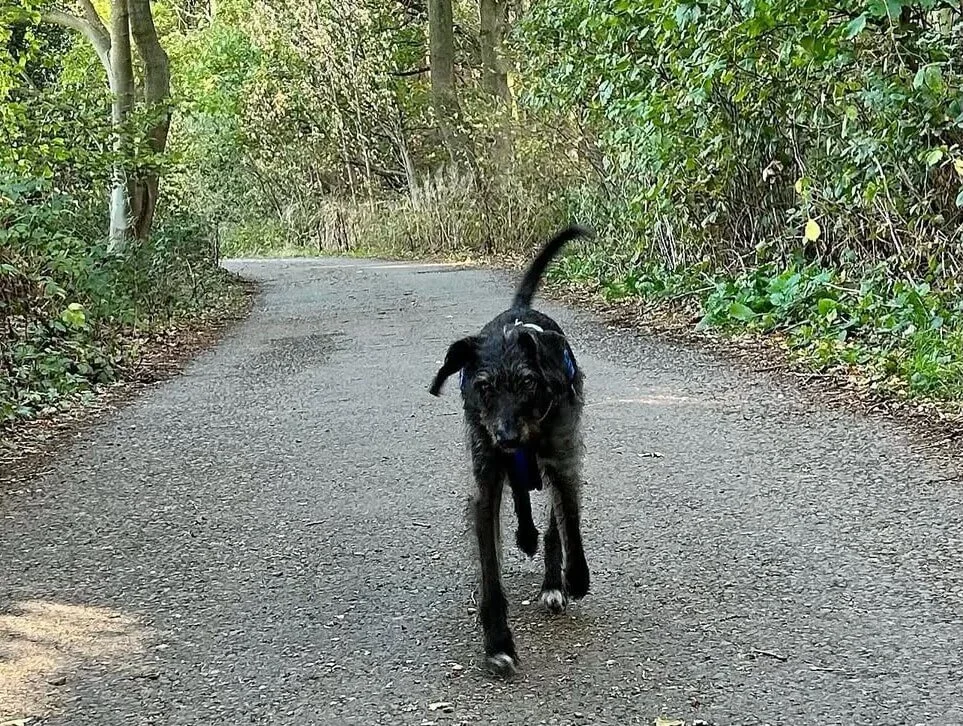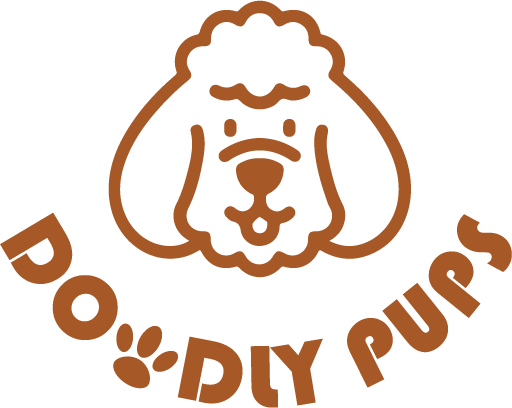You’re going to love Whoodles! This captivating canine is a delightful mix of two amazing breeds: the sleek, athletic Whippet and the intelligent, versatile Poodle. Combining the best of both worlds, Whoodles are as charming as they are functional. You’ll find yourself captivated by their affectionate nature, high intelligence, and that irresistible blend of sleekness and fluff.
What makes the Whoodle so popular? Their incredible adaptability! Whether you’re a busy professional dreaming of a low-maintenance companion, a family looking for a playful yet gentle addition, or an active individual searching for the perfect running buddy, the Whoodle can easily fit into your life. And let’s not forget their hypoallergenic coats – a huge plus for allergy sufferers!
This guide will tell you everything you need to know about Whoodles. We’ll delve into their unique appearance and temperament, explore their exercise needs, and discuss those grooming requirements. You’ll learn about the fascinating blend of Whippet and Poodle traits, discover tips for training and socialization, and ultimately decide if a Whoodle is the perfect match for your family.
As someone with years of experience breeding and raising Poodle mixes, I’ll share insights and personal anecdotes to help you make an informed decision.Let’s learn all about Whoodles together!
Breed Overview
What is a Whippet Poodle Mix?

Imagine a dog that’s all sleek lines and playful energy, with a dash of intelligence and a hypoallergenic coat. That’s the Whoodle, a delightful mix of the athletic Whippet and the elegant Poodle. Whippets are known for their calm, affectionate nature and that signature “hound dog” grace. Poodles, on the other hand, are renowned for their smarts, adaptability, and those famously curly coats. Combine these traits, and you get a dog that’s not only visually stunning but also a joy to live with.
Whoodles come in a range of sizes, depending on whether a Standard, Miniature, or Toy Poodle was part of the mix. They often inherit the Whippet’s lean and agile build, but with a coat that can range from wavy to tightly curled. These dogs are simply captivating – a blend of grace, intelligence, and warmth that makes them a fantastic fit for many households.
Alternative Names
“Whoodle” is the most common and arguably the cutest nickname for this delightful mix. It’s catchy, playful, and perfectly captures their endearing nature. You might also hear them called Whipoo, Whippoodle, or Poowhip, each reflecting a bit of their unique charm. But let’s be honest, “Whoodle” just rolls off the tongue, doesn’t it?
Brief History
The Whoodle is a relatively new kid on the block in the world of designer dogs. The “designer dog” craze really took off in the last couple of decades, with breeders intentionally crossing purebreds to create dogs with the best of both worlds. Think improved health, unique looks, and truly wonderful temperaments.
The Whippet, with its roots in England, was originally bred for racing and hunting. These sleek, speedy dogs were incredibly popular among working-class folks, often described as “the poor man’s Greyhound” for their efficiency and affectionate companionship.
The Poodle, meanwhile, has a long and distinguished history. Originally bred as water retrievers in Germany, they gained immense popularity in France, adored by royalty for their intelligence, trainability, and those hypoallergenic coats. Poodles come in three sizes – Standard, Miniature, and Toy – offering a perfect fit for almost any lifestyle.
The idea behind crossing Whippets and Poodles was to create a dog that combined the best of both breeds. You get the Whippet’s athleticism and affectionate personality paired with the Poodle’s intelligence and low-shedding coat. It’s a winning combination that appeals to a wide range of dog lovers, from those with allergies seeking a furry friend to active families looking for a playful yet calm companion.
From my experience with Poodle mixes, the Whoodle truly stands out. They seem to have a wonderful balance of energy and affection. While they may not have centuries of history like some breeds, Whoodles are quickly making their mark. Their unique blend of traits and that irresistible charm make them a delightful addition to any family.
Appearance
Physical Traits

The Whoodle, a delightful mix of Whippet and Poodle, is a true one-of-a-kind. Their appearance can vary wildly depending on which Poodle parent they inherit their traits from – Standard, Miniature, or Toy. You’ll often find them with that lean, athletic build their Whippet side gives them, long legs and all. But don’t be fooled! They’re not just all bones.
There’s a grace and elegance to their movement, a hint of the Poodle’s more robust physique. Imagine a toned athlete draped in a cloud of soft curls or waves – that’s the Whoodle.
Size-wise, they come in all shapes and sizes. If their Poodle parent was a Standard, you’re looking at a medium-sized dog, maybe 18 to 25 inches tall and weighing in between 30 and 50 pounds. On the other hand, if they have Miniature or Toy Poodle blood, they’ll be much smaller, closer to 12 to 18 inches tall and weighing 15 to 30 pounds. No matter their size, they all share that aerodynamic build from their Whippet side, making them incredibly agile and light on their feet.
And let’s talk about their coats! Many inherit the Poodle’s signature curls or waves, but some might have a straighter, more Whippet-like coat. Regardless, their fur is usually incredibly soft and luxurious.
Coat Colors and Patterns
Whoodles come in a dazzling array of colors and patterns, making each one truly unique. Their Whippet side brings shades like fawn, brindle, black, and blue to the table, while the Poodle adds classic colors like white, black, apricot, silver, and chocolate. The result? A stunning array of possibilities! You might find them in solid colors, with captivating multi-colored patterns, or even sporting striking brindle markings.
Some Whoodles have this amazing patchy or speckled coat, where colors blend together in the most beautiful way. Others might have a single, uniform color with subtle highlights. It truly depends on the unique genetic mix of their parents, making each Whoodle one-of-a-kind.
Hypoallergenic Potential
One of the biggest draws of the Whoodle is their potential to be hypoallergenic, thanks to that Poodle heritage. Poodles are famous for their low-shedding coats, which produce less dander – that stuff that can trigger allergies in some people. While not every Whoodle will be completely allergy-free, many inherit this trait, making them a fantastic option for those with mild allergies.
Now, let’s be real: “hypoallergenic” doesn’t mean “allergy-proof.” Even within the same litter, the amount of allergens produced can vary greatly. If you have allergies, it’s crucial to spend some time with the specific Whoodle you’re considering to see how you react.
Beyond being potentially hypoallergenic, their coats are generally much easier to maintain than a Whippet’s. Less shedding means less mess, which is always a plus for indoor living! Regular grooming, like brushing and the occasional trim, will keep their coat looking its best and minimize any allergen buildup.
From their sleek and fluffy looks to their allergy-friendly potential, the Whoodle is a truly unique and wonderful breed. Whether you’re captivated by their striking appearance, drawn to their low-shedding coats, or simply need a dog that fits your lifestyle, there’s a Whoodle out there for everyone.
Personality and Temperament
Key Behavioral Traits

Whoodles are a delightful mix of smarts, friendliness, and energy. These pups are incredibly bright – you wouldn’t believe how quickly they pick up new tricks! That’s thanks to their Poodle side, known for being among the smartest breeds. But don’t worry, they’re not all brains and no brawn. Their Whippet heritage lends them a calm and affectionate nature, making them a joy to be around.
Whoodles are real people-pleasers who love to be part of the family. They form deep bonds with their families and are incredibly loyal and attentive companions. They’re playful, of course, but not overly boisterous, making them a great fit for many different living situations. They enjoy their daily walks and playtime, but they’re also perfectly content to curl up beside you on the couch for a good snuggle.
One of the things I love most about Whoodles is their gentle nature. They’re incredibly sensitive and truly pick up on your emotions. Need a furry shoulder to cry on? Your Whoodle will be there for you. This makes them wonderful therapy or emotional support animals. However, their sensitive side means they don’t respond well to harsh training. Positive reinforcement and patience are key – think rewards and encouragement, not yelling.
Influence of Parent Breeds
Whoodles inherit a fantastic blend of traits from both their Whippet and Poodle parents.
Whippet Traits:
Whippets are known for their calm and affectionate personalities. They’re often called “velcro dogs” because they love to be close to their humans – practically glued to your side! They’re also independent thinkers, which can sometimes lead to a bit of stubbornness. But don’t worry, they generally want to please you, so a little patience and kindness go a long way.
Poodle Traits:
Poodles are bundles of energy and intelligence! They love mental stimulation and thrive on challenges. They’re incredibly playful and social, getting along famously with both people and other animals.
When you combine these traits, you get a dog that’s both laid-back and alert. The Whippet’s calm demeanor balances out the Poodle’s higher energy, creating a well-rounded personality that adapts beautifully to different environments. And let me tell you, these dogs are quick learners! The Poodle’s intelligence boosts their trainability, making them excel in obedience and agility classes.
Compatibility
Whoodles are incredibly versatile and fit well into many different lifestyles.
Families:
Whoodles are fantastic family dogs. They’re patient and gentle with kids, making them a wonderful addition to any household. They love to play and interact, but they’re also happy to chill out when the kids are busy.
Singles or Couples:
For singles or couples, Whoodles make wonderful companions. They crave attention and are perfectly content to be the center of your world. Their moderate exercise needs mean they can thrive in apartment living, as long as you take them for daily walks and provide plenty of mental stimulation.
Multi-Pet Households:
Whoodles are generally very social and get along well with other dogs and even cats. Early socialization is always important, but their easygoing personalities usually make for a harmonious household.
In my experience, Whoodles are incredibly adaptable. I’ve seen them thrive in both bustling city apartments and peaceful country homes. They seamlessly adjust to their owners’ routines and lifestyles. Whether you’re an active adventurer or someone who prefers a more relaxed pace of life, a Whoodle will love to be by your side.
Whether you’re looking for a family dog, a loyal companion, or a furry friend to share your adventures with, the Whoodle’s blend of intelligence, friendliness, and energy makes them a truly wonderful addition to any home.
Training and Socialization
Trainability

The Whippet Poodle mix, affectionately known as the Whoodle, is a dream to train. They’re incredibly smart, thanks to the brainpower of both parent breeds. Poodles are famous for their quick learning and problem-solving, while Whippets bring a bit of independence but a strong desire to please when handled with patience.
Whoodles are naturally curious and love engaging with their surroundings, making them eager learners. They shine in activities that challenge their minds—like obedience training, agility courses, or brain-teasing games. With their knack for picking up commands and routines, Whoodles excel at everything from basic manners to advanced tricks. Some even thrive in specialized roles like therapy or agility competitions.
In my experience, their trainability is one of their most endearing traits. I’ve worked with Whoodles who mastered recall, leash manners, and sit-stay commands in just a few sessions. That said, their intelligence can work against you if training becomes repetitive—they’ll lose interest fast! Keeping things fresh and creative is the secret to success.
Effective Training Methods
When it comes to training a Whoodle, positive reinforcement is your best friend. They respond beautifully to praise, treats, and even a favorite toy as a reward. It’s not just about teaching behaviors—it’s about building trust and strengthening your bond.
Here are some tried-and-true tips:
- Start Early: Puppies are like little sponges. The sooner you begin housebreaking, teaching commands, and establishing good habits, the better.
- Keep It Short: Their attention spans are decent, but long sessions can lead to boredom. Stick to 10–15 minutes and focus on one thing at a time.
- Be Consistent: Always use the same words and cues for specific actions. It avoids confusion and helps your pup feel secure.
- Mix It Up: Whoodles love variety! Try games like fetch, hide-and-seek, or puzzle toys to keep your Whoodle curious and mentally sharp.
- Avoid Harsh Discipline: These sensitive souls don’t respond well to heavy-handed approaches. Instead, redirect bad behavior and celebrate the good stuff.
I’ve found that making training fun works wonders. For example, teaching a puppy to “stay” can turn into a playful challenge—add a tasty treat as a reward and gradually increase the distance. It’s incredible to see how excited Whoodles get when they realize training is just another way to have fun with you.
Socialization Tips
Socializing your Whoodle early is key to raising a well-adjusted dog. While the Whippet side can make them a bit shy, the Poodle genes balance things out with their friendly, outgoing nature. But even the friendliest pup benefits from focused socialization.
Here’s how to help your Whoodle grow into a confident, happy dog:
- Explore New Places: Take them on mini-adventures to parks, pet-friendly stores, or even outdoor cafes. New sights, sounds, and smells will boost their confidence.
- Meet New Faces: Arrange calm interactions with kids, adults, and other pets. These early experiences teach them how to handle different situations.
- Reward Bravery: When your pup stays calm in a new situation, let them know they’ve nailed it. Treats, praise, or playtime work wonders.
- Join Puppy Classes: These are fantastic for structured socialization. Your Whoodle will meet other pups and learn alongside them in a controlled environment.
- Take It Slow: If they’re hesitant, don’t rush them. Give them time to approach new things at their own pace.
One Whoodle I worked with was pretty timid around other dogs at first. But with patience, gradual exposure, and plenty of treats, they transformed into a confident social butterfly. A little encouragement can make a world of difference.
By combining early socialization with effective training, you’ll set your Whoodle up to be a well-behaved, adaptable companion. With love, patience, and a sprinkle of creativity, you’ll have a pup who’s not just well-mannered but also an absolute joy to be around.
Exercise Needs
Daily Activity Requirements

The Whoodle, a mix of the athletic Whippet and the lively Poodle, brings together the best of both worlds when it comes to energy levels. They’re up for fun and games but equally enjoy some downtime with their family.
On average, Whoodles need 45 minutes to an hour of physical activity daily. This can range from brisk walks and jogs to playful sessions at the dog park. Their Whippet genes mean they’ll love sprinting and burning off bursts of energy, while the Poodle side keeps them curious and eager to play. Fetch, tug-of-war, and even agility courses are excellent ways to keep them fit and happy.
That said, Whoodles aren’t high-strung. After meeting their exercise quota, they’re content to chill out at home. This balance makes them a great fit for families that enjoy an active lifestyle with plenty of couch time too.
From my experience, tailoring their routine to their size and energy level is key. Standard Whoodles often need more intense workouts, while Miniature or Toy mixes may thrive on shorter, gentler activities. One client with a Toy Poodle-Whippet mix found two 20-minute walks and a bit of indoor play kept their pup perfectly satisfied.
Mental Stimulation
Exercise is only part of the equation. Whoodles are smart cookies and need plenty of mental stimulation to stay out of trouble. Without it, they might channel that brainpower into chewing your favorite shoes!
Ideas for Mental Enrichment:
- Puzzle Toys: Treat-dispensing toys are a hit for keeping their minds engaged.
- Hide-and-Seek: Hide treats or toys around the house and let them sniff them out. It’s like a treasure hunt for dogs!
- Training Time: Teaching tricks or commands isn’t just fun; it strengthens your bond and satisfies their craving to learn.
- Interactive Play: Games like tug-of-war or a lively round of fetch keep their bodies and minds active.
Best Toys for Whoodles:
- Tough chew toys to satisfy their love of gnawing.
- Rope toys for tugging and interactive fun.
- Soft plush toys, especially for smaller Whoodles who like gentle play.
A trick I often recommend is rotating their toys. It’s a simple way to keep things fresh. One family I worked with used this strategy, and their Whoodle was thrilled to “rediscover” old favorites. It’s like Christmas every week!
Living Situations
One of the great things about Whoodles is how adaptable they are. Whether you’re in a city apartment or a suburban house, they can thrive as long as their needs are met.
In Apartments:
Whoodles are well-suited to apartment living if you provide regular exercise and mental enrichment. They’re usually polite and quiet indoors, which is a big plus when living in close quarters.
In Homes with Yards:
If you’ve got a yard, even better! Their Whippet ancestry means they’ll love sprinting around a safe, enclosed space. Just make sure the yard is secure—these pups can be quick to chase after squirrels or birds.
Regardless of where you live, Whoodles need consistent interaction. They’re social dogs that don’t do well if left alone for long stretches.
I once worked with a client in a city high-rise who raised a Standard Whoodle. They balanced daily walks with weekend trips to dog parks and used puzzle toys during work hours. On the flip side, a suburban family with a spacious yard still made time for structured walks to keep their Whoodle on a routine. Both dogs thrived because their families prioritized bonding time.
Grooming Requirements
Coat Care

The Whippet Poodle mix, or Whoodle, boasts a coat that can vary wildly—from the silky softness of a Whippet to the dense curls of a Poodle. Most Whoodles land somewhere in the middle, sporting a soft, wavy, or curly coat that demands regular attention to keep it tangle-free and healthy.
Brushing:
Brushing is a must for any Whoodle to prevent matting and tangles, which can cause discomfort and even skin irritation. Aim for at least 2-3 brushings per week, but daily brushing might be necessary for those with thicker or curlier coats. A slicker brush or a comb designed for curly-haired breeds works wonders for gently detangling and removing loose hair.
Trimming:
Whoodle coats grow continuously, much like human hair. This means regular trims every 6-8 weeks are essential to maintain a manageable length and prevent excessive growth. You can either take your dog to a professional groomer or learn basic grooming techniques yourself, such as trimming around the face, paws, and sensitive areas. From personal experience, I highly recommend finding a groomer experienced with Poodle mixes, as they understand the unique needs of these coats.
Bathing:
Whoodles typically need a bath every 4-6 weeks, or more often if they’re particularly active or their coat gets dirty. Use a mild, dog-safe shampoo to avoid stripping their natural oils. After bathing, be sure to thoroughly dry their coat and brush it to prevent tangles.
Shedding Levels
One of the biggest draws of Whoodles is their reputation for low shedding, thanks to their Poodle heritage. Poodles are hypoallergenic and shed very little, while Whippets shed moderately. Depending on which parent’s traits dominate, your Whoodle might be a minimal shedder or shed lightly.
For most Whoodles, shedding is barely noticeable, making them a fantastic choice for those with allergies or who prefer a cleaner home. However, even low-shedding dogs need regular grooming to manage loose hairs and keep their coat healthy.
In my experience, Whoodles with curlier coats tend to shed less than those with straighter coats. I once had a client whose Whoodle shed almost nothing thanks to its tight, Poodle-like curls. On the other hand, another Whoodle with a softer, straighter coat shed lightly, but still significantly less than many other breeds.
Maintaining Healthy Skin
A dog’s coat can only be as beautiful as the skin it grows from. Whoodles, like many breeds, can be prone to dry or irritated skin, especially if they inherit the sensitive skin of their Whippet parent. Here are some tips to keep your Whoodle’s skin in top condition:
- Use High-Quality Products: Always choose shampoos and conditioners specifically formulated for dogs. Look for products with natural ingredients like oatmeal or aloe vera to soothe sensitive skin. Avoid human shampoos or harsh chemicals, as these can dry out or irritate their skin.
- Regular Brushing: Brushing isn’t just about preventing tangles—it also stimulates the skin and distributes natural oils throughout the coat, leading to healthier skin and a shinier appearance.
- Balanced Diet: A balanced diet plays a crucial role in skin and coat health. Foods rich in omega-3 and omega-6 fatty acids, such as fish or supplements, help keep their skin hydrated and their coat glossy. If you notice dryness or dandruff, consult your vet about adding fish oil or other supplements to their diet.
- Monitor for Allergies: Both Whippets and Poodles can be prone to allergies, which can manifest as itchy skin, redness, or excessive licking. Common allergens include certain foods, pollen, or even grooming products. If you suspect an allergy, consult your vet to identify the trigger and adjust their care accordingly.
- Hydration and Environment: Ensure your dog always has access to fresh water. In colder months, consider using a humidifier if your home’s air is particularly dry, as this can help prevent your Whoodle’s skin from drying out.
From personal experience, incorporating regular grooming sessions with skin checks is essential. I once worked with a Whoodle who developed mild irritation due to an overly fragrant shampoo. Switching to a hypoallergenic, fragrance-free option made a world of difference, and the owner noticed an immediate improvement in both the dog’s coat and comfort level.
By diligently following their grooming and skin care routine, you’ll ensure your Whoodle looks and feels their best, while also strengthening the bond you share through regular care and attention.
Health and Lifespan

Common Health Concerns
Whoodles, the delightful mix of Whippet and Poodle, are generally healthy dogs, thanks to the “hybrid vigor” that often comes with mixed breeds. However, like all dogs, they can inherit certain health conditions from their parents.
Hip dysplasia is a common concern, especially since Poodles can be prone to it. This means the hip joint doesn’t develop properly, leading to arthritis and discomfort later in life. Keeping your Whoodle at a healthy weight, providing regular exercise, and considering supplements like glucosamine can help.
Progressive Retinal Atrophy (PRA), an inherited eye condition that causes gradual vision loss, can also affect Whoodles. Both Whippets and Poodles can carry the gene for PRA, so responsible breeders often screen their dogs to minimize the risk of passing it on to puppies.
Whippets are known for having sensitive skin, and this trait can sometimes be passed down to Whoodles. Skin allergies or irritations can pop up due to things like food, grooming products, or environmental factors. Keep an eye out for excessive scratching, redness, or dryness – these are signs something might be bothering your dog’s skin.
Bloat, a potentially life-threatening condition where the stomach twists and traps gas, is a risk for deep-chested breeds like Whippets. To minimize the risk, avoid feeding your Whoodle one giant meal and don’t let them exercise vigorously right after eating.
Those floppy ears that are so adorable can also be a bit of a trouble spot. Moisture can get trapped in them, leading to ear infections. Regular ear cleaning and drying, especially after baths or swims, is a must!
I remember one client whose Whoodle developed mild arthritis due to early-stage hip dysplasia. We worked together on a plan that included weight management, gentle exercise, and joint supplements. The dog lived a long, happy life, proving that even with some health challenges, a proactive approach can make a huge difference.
Lifespan
Whoodles generally live a good long life, usually between 12 and 15 years. Factors like size, genetics, and how well you care for them all play a role in their lifespan. Smaller Whoodles, like those bred from Miniature or Toy Poodles, might live a bit longer than their larger Standard counterparts.
To help your Whoodle live their best life, focus on providing a balanced diet, regular exercise, and regular vet checkups. Don’t forget about their mental well-being too! Whoodles are social creatures who thrive on interaction and love being included in family activities.
I recall one Whoodle owner who swore by a consistent routine of nutritious homemade meals and frequent vet checkups. Their dog lived to a fantastic 16 years old, a testament to the power of preventative care.
Preventative Care
Preventative care is key to keeping your Whoodle healthy and happy.
Regular Vet Checkups: Schedule annual (or even more frequent for seniors) checkups with your vet. These visits help catch potential problems early on when they’re easier to treat.
Vaccinations and Parasite Prevention: Keep those core vaccinations like rabies and distemper up to date. And don’t forget about parasites like fleas, ticks, and heartworms! Use vet-recommended preventatives to keep your Whoodle protected.
Dental Care: Good dental hygiene is crucial! Brush their teeth regularly with dog-specific toothpaste and consider professional cleanings as needed. Poor dental health can lead to gum disease, tooth loss, and even more serious health issues.
Feed your Whoodle good food that’s right for their size and how active they are. Look for foods rich in essential nutrients, like omega-3 fatty acids for healthy skin and coat, and glucosamine to support their joints. Avoid overfeeding, as obesity can worsen health problems like hip dysplasia.
Exercise and Enrichment: Keep your Whoodle active with regular exercise and mental stimulation. This not only keeps them physically fit but also helps reduce stress and prevents behavioral problems.
Spaying/Neutering: Spaying or neutering your Whoodle can help prevent certain health problems, like uterine infections in females and testicular cancer in males. Talk to your vet about the best time to do this.
I remember one Whoodle who suffered from recurring ear infections. The problem stemmed from improper ear cleaning. After we implemented a simple weekly cleaning routine, the infections disappeared completely!
By being proactive and attentive to your Whoodle’s needs, you can help them live a long, healthy, and happy life filled with joy and companionship.
Diet and Nutrition
Ideal Diet
If you’ve got a Whippet Poodle mix, or Whoodle, in your life, you already know they’re a special blend of energy, intelligence, and charm. Keeping them healthy starts with a well-balanced diet that’s tailored to their size, activity level, and overall health. Think of it as fueling a high-performance car—you want the best to keep them running smoothly.
Key Nutritional Components:
- Protein:
Whoodles are active little athletes, so protein is a must. It’s the building block for strong muscles and helps them recover after a day of zoomies or agility training. High-quality sources like chicken, turkey, fish, or lamb are ideal. Picture your Whoodle wagging their tail at the sight of a juicy piece of grilled chicken—it’s their version of a gourmet meal! - Healthy Fats:
Want your Whoodle to have a coat that shines like a star? Omega-3 and Omega-6 fatty acids are your go-to. Fish oil, flaxseed, and poultry fat not only keep their coat glossy but also support brain health. It’s like giving them a spa day from the inside out. - Complex Carbohydrates:
Carbs are the energy boosters that keep your Whoodle playful and active. Brown rice, sweet potatoes, and quinoa are excellent choices—they’re easy to digest and provide long-lasting energy. Think of it as their version of a power snack. - Vitamins and Minerals:
Don’t skimp on the veggies and fruits! Spinach, carrots, and blueberries are packed with antioxidants and vitamins that boost their immune system and keep them feeling their best. It’s like a daily dose of wellness in every bite. - Fiber:
A happy tummy means a happy dog. Ingredients like pumpkin or beet pulp can help keep their digestion on track and prevent any unpleasant surprises. Trust me, you’ll be glad you added this to their diet.
What’s the Best Food for a Whoodle?
In my experience, most Whoodles thrive on premium commercial dog foods labeled as complete and balanced. But if you’re feeling adventurous, homemade diets or raw feeding can work too—just make sure to consult your vet first. I once worked with a Whoodle owner who swore by a homemade diet, and their pup had the energy of a puppy well into their senior years!
Feeding Guidelines
Feeding your Whoodle isn’t just about filling their bowl—it’s about giving them the right amount of food at the right times to keep them healthy and happy.
Portion Sizes:
The amount of food your Whoodle needs depends on their size, age, and activity level. Here’s a quick guide:
- Small Whoodles (Miniature or Toy Poodle Mix): 1–1.5 cups of kibble per day.
- Standard Whoodles: 2–3 cups of kibble per day.
Split their daily portion into two meals—one in the morning and one in the evening. This helps prevent overeating and reduces the risk of bloating, especially in larger Whoodles. And yes, measuring their food is a must. Those puppy-dog eyes might convince you to pour a little extra, but trust me, portion control is key to avoiding obesity.
Puppy Feeding:
Puppies are little balls of energy, so they need more frequent meals. Feed them 3–4 smaller meals a day until they’re about six months old, then gradually transition to two meals as they grow.
Adjusting for Activity:
If your Whoodle is a superstar at agility training or loves long hikes, they might need a bit more food to keep up. On the flip side, couch potato Whoodles might need smaller portions to avoid packing on the pounds. One of my clients had a Whoodle who was a total agility champ. They added an extra half-cup of kibble on training days, and it made all the difference in keeping their pup energized and lean.
Foods to Avoid
While Whoodles aren’t usually super sensitive, there are some foods that should never make it into their bowl. Here’s what to watch out for:
- Toxic Foods:
- Chocolate: It’s a treat for us, but it’s toxic for dogs. Theobromine, a compound in chocolate, can cause serious health issues.
- Grapes and Raisins: These can lead to kidney failure, so keep them far away from your pup.
- Onions and Garlic: They can damage red blood cells, leading to anemia.
- Avocado: Contains persin, which can be harmful in large amounts.
- Xylitol: This sugar substitute, found in some sugar-free products, can cause a dangerous drop in blood sugar.
- Table Scraps and Fatty Foods:
As tempting as it is to share your dinner, table scraps and fatty foods can lead to pancreatitis or digestive issues. Stick to dog-friendly treats instead. - Artificial Additives:
Avoid foods with artificial colors, preservatives, or fillers like corn and soy. These can trigger allergies or sensitivities in some dogs.
Recommended Supplements:
If you want to give your Whoodle an extra boost, consider these supplements:
- Fish Oil: Great for a shiny coat and reducing inflammation.
- Glucosamine and Chondroitin: Perfect for supporting joint health, especially in larger Whoodles prone to hip dysplasia.
- Probiotics: These can improve gut health and digestion.
I’ve seen firsthand how supplements can make a difference. One senior Whoodle I worked with had mild arthritis, and after adding a glucosamine supplement to their diet, they were running around like a puppy again. It was amazing to see!
By focusing on high-quality nutrition, proper portion control, and avoiding harmful foods, you’ll set your Whoodle up for a long, healthy, and active life. And let’s be honest—there’s nothing better than seeing your furry friend happy, healthy, and full of energy!
Is a Whippet Poodle Mix Right for You?

Choosing the right dog for your lifestyle is a big decision—it’s like adding a new member to your family. The Whippet Poodle mix, affectionately called a Whoodle, is a charming and unique breed, but they’re not a one-size-fits-all kind of dog. Let’s dive into their pros and cons, the type of owner they’re best suited for, and some key questions to ask yourself before bringing one home.
Pros and Cons
Pros:
- Intelligent and Trainable:
Thanks to their Poodle genes, Whoodles are whip-smart and love to learn. They pick up commands quickly and thrive on mental challenges. If you’ve ever dreamed of having a dog that can master tricks or even agility courses, a Whoodle might be your perfect match. - Low-Shedding Coat:
Many Whoodles inherit the Poodle’s hypoallergenic coat, which is a huge plus for allergy sufferers. Plus, less shedding means less time spent vacuuming dog hair off your couch. - Friendly and Affectionate:
Whoodles are total lovebugs. They bond deeply with their families and want to be part of everything you do. If you’re looking for a dog that will follow you around the house and snuggle up on the couch, this breed has you covered. - Adaptable Size:
Depending on whether they’re mixed with a Standard, Miniature, or Toy Poodle, Whoodles come in a range of sizes. This makes them a great fit for everything from cozy apartments to spacious homes with yards. - Energetic and Playful:
These pups are bursting with energy and can’t get enough of playtime. Whether it’s a game of fetch or a hike in the woods, they’re always up for an adventure.
Cons:
- High Grooming Needs:
That beautiful coat doesn’t maintain itself. Whoodles need regular brushing, trimming, and occasional trips to the groomer. If you’re not up for the commitment, their fur can quickly become matted and uncomfortable for them. - Separation Anxiety:
Whoodles form strong bonds with their families and don’t like being left alone for long periods. If you’re away from home a lot, this breed might not be the best fit. - Variable Temperament:
As a hybrid breed, Whoodles can take after either parent. Some might be more laid-back like a Whippet, while others inherit the Poodle’s high energy and sociability. It’s a bit of a genetic lottery! - High Energy Levels:
While their playful nature is endearing, it can be a challenge if you’re not able to keep up with their exercise needs. A bored Whoodle might resort to mischief to entertain themselves. - Potential Health Concerns:
Like all breeds, Whoodles can be prone to certain health issues, such as hip dysplasia, skin sensitivities, or eye problems. Make sure to schedule regular vet visits to keep your Whoodle in great health and feeling their best.
Ideal Owner Profile
Whoodles aren’t for everyone, but they’re a dream come true for the right owner. Here’s who they’re best suited for:
- Active Individuals or Families:
If you love spending time outdoors—whether it’s hiking, running, or playing fetch—a Whoodle will be your perfect adventure buddy. - Homes with Time for Training:
These dogs are smart and need mental stimulation. If you enjoy teaching tricks or trying out dog sports like agility, you’ll have a blast with a Whoodle. - People Who Are Home Often:
Whoodles thrive in homes where they’re not left alone for long stretches. If you work from home or have a flexible schedule, this breed will fit right in. - Families with Older Children:
While Whoodles are generally great with kids, their playful energy might be too much for very young children. Families with older kids who can help with their care and exercise will find them a wonderful addition. - Committed Groomers:
If you don’t mind spending time brushing their coat or scheduling regular grooming appointments, you’ll keep your Whoodle looking and feeling their best.
I once helped match a Whoodle puppy with an active couple who worked from home. They spent their mornings hiking and their evenings teaching the dog new tricks. It was a perfect match, and the Whoodle flourished in their care.
Questions to Consider
Before bringing a Whoodle into your life, ask yourself these questions to make sure it’s the right fit:
- Can You Commit to Regular Grooming?
Are you ready to brush their coat several times a week and take them to the groomer every few months? - Do You Have Time for Exercise and Training?
Whoodles need daily physical activity and mental stimulation. Can you dedicate time each day to walks, playtime, and training? - Is Your Home Suitable?
Whether you live in an apartment or a house with a yard, can you provide a safe and comfortable space for your Whoodle? - How Much Time Are You Away from Home?
If you’re frequently out of the house for long hours, can you arrange for doggy daycare, a pet sitter, or a companion animal? - Are You Financially Prepared?
Beyond the initial cost of adopting or purchasing a Whoodle, are you ready for ongoing expenses like grooming, food, and vet care? - What Are Your Expectations?
Are you looking for a dog that will cuddle on the couch, or are you seeking an active companion? Understanding what you want in a pet will help determine if a Whoodle aligns with your lifestyle.
One family I worked with realized after answering these questions that a Whoodle wasn’t the best fit for their busy, travel-heavy lifestyle. They ultimately decided on a lower-maintenance breed, which was a better match for their needs.
By weighing the pros and cons, reflecting on your lifestyle, and asking the right questions, you can determine if a Whippet Poodle mix is the perfect companion for your home. And if they are, get ready for a lifetime of love, laughter, and adventure with your new furry friend!
Finding a Whippet Poodle Mix
Bringing a Whippet Poodle mix—affectionately called a Whoodle—into your life is an adventure filled with wagging tails and endless cuddles. But before you dive in, it’s important to do your homework. Whether you’re working with a breeder or adopting through a rescue, your goal is the same: to find a happy, healthy dog and give them the loving home they deserve. Trust me, the effort you put into finding the right Whoodle will pay off in spades.
Reputable Breeders
If you’re leaning toward getting a Whoodle from a breeder, it’s crucial to find one who truly cares about their dogs. Here’s how to spot the good ones:
Research and Referrals
Start by digging into breeders who specialize in Poodle mixes. Ask around—your vet, local breed clubs, or even that friend who’s obsessed with their dog might have great recommendations. Online forums can also be a goldmine of info.
Visit the Breeder
A good breeder will welcome you with open arms (and probably a few wagging tails). When you visit, take note of the living conditions. Are the dogs clean, happy, and well-socialized? Puppies should be in a stimulating environment, not crammed into a tiny space. If it feels off, trust your gut.
Meet the Parents
Ask to meet the puppy’s mom and dad. Their health and temperament will give you a sneak peek into what your future pup might be like. Are they friendly, relaxed, and well-cared-for? If so, that’s a great sign.
Health Testing
Reputable breeders don’t cut corners. They’ll have health test results for the parents to rule out inherited conditions like hip dysplasia or eye issues. Don’t be shy—ask to see these records. A responsible breeder will be proud to share them.
Ask Questions (and Expect Some in Return)
A good breeder will grill you just as much as you grill them. They’ll want to know about your lifestyle, experience with dogs, and why you’re interested in a Whoodle. This isn’t nosiness—it’s a sign they care about finding the right home for their pups.
Red Flags to Watch For
Steer clear of breeders who:
- Won’t let you visit their facility.
- Offer puppies younger than 8 weeks.
- Seem to have a never-ending supply of litters.
- Are more interested in your wallet than your home environment.
I’ve worked with breeders who go the extra mile, sending puppies home with starter kits, health guarantees, and even lifetime support. These are the folks who truly love what they do.
Rescue and Adoption
Adopting a Whoodle is a heartwarming way to give a dog a second chance. Here’s how to get started:
Breed-Specific Rescues
Look for rescues that specialize in Poodle mixes or Whippets. They often have Whoodles or similar mixes, and they’ll know the dog’s history and personality inside and out.
Local Shelters
Don’t overlook your local animal shelter. While Whoodles might not be common, you never know when one might pop up. Call ahead and let them know what you’re looking for.
Online Platforms
Websites like Petfinder and Adopt-a-Pet are fantastic resources. You can search by breed, age, and location to find your perfect match. Many rescues also post adoptable dogs on social media, so keep an eye out.
Patience is Key
Finding a Whoodle through adoption might take time, but it’s worth the wait. I once helped a family adopt a young Whoodle who’d had a rough start in life. With a little patience and a lot of love, that dog blossomed into the most loyal, goofy companion.
Puppy Checklist
Whether you’re buying from a breeder or adopting, here’s what to look for to ensure your new pup is healthy and ready to thrive:
Health Indicators
- Eyes and Ears: Bright, clear eyes and clean, odor-free ears are a must.
- Coat: A shiny, soft coat without redness or bald spots is a good sign.
- Energy Level: Puppies should be curious and playful, not lethargic or overly shy.
- Weight: They should look proportional—not too skinny, not too chubby.
Vaccination and Deworming
Ask for records showing the puppy’s first round of shots and deworming. A reputable breeder or rescue will have no problem providing these.
Socialization
Puppies need early exposure to different sights, sounds, and experiences. Ask how the breeder or rescue has socialized the pups. Are they comfortable around people and other animals? A well-socialized puppy is more likely to grow into a confident, happy dog.
Support from Breeder or Rescue
- Breeder: They should offer a health guarantee, a detailed history of the puppy, and tips for settling them into your home.
- Rescue: They should provide insights into the dog’s personality and any training or medical care they’ve received.
Observe Their Environment
Puppies raised in clean, enriching spaces are more likely to be well-adjusted. Avoid places that feel overcrowded or unsanitary.
I once helped a client choose between two Whoodle puppies. After watching their interactions and asking the breeder a million questions, they went with the playful, curious one. That pup turned out to be the perfect match for their active lifestyle.
Conclusion
The Whippet Poodle mix, affectionately known as the Whoodle, is the kind of dog that steals your heart the moment they wag their tail. Imagine a furry bundle of intelligence, affection, and adaptability—wrapped up in one irresistibly charming package.
Whether you’re searching for a loyal sidekick, a playful partner for outdoor adventures, or a low-shedding buddy for an allergy-prone household, the Whoodle checks all the boxes.
In this guide, we’ve taken a deep dive into what makes the Whoodle so special:
- Breed Characteristics: Their compact size, curly or wavy coat, and hypoallergenic qualities make them a great fit for almost any home.
- Personality and Temperament: These dogs are whip-smart, friendly, and thrive on bonding with their humans. Just be ready to keep up with their energy—they love a good romp in the park!
- Training and Care Needs: Whoodles are eager to please, but they do best with consistent grooming, regular exercise, and plenty of socialization.
- Health and Nutrition: A balanced diet and routine vet checkups go a long way in keeping your Whoodle happy and healthy for years to come.
- Finding Your Match: Whether you adopt from a rescue or work with a reputable breeder, choosing a well-socialized, healthy pup is key.
Making an Informed Decision
Bringing a Whoodle into your life isn’t just a decision—it’s the start of a beautiful friendship. But like any relationship, it takes effort and understanding. Before you take the plunge, ask yourself:
- Does my lifestyle match the Whoodle’s need for activity and companionship?
- Am I ready for the grooming routine and occasional bursts of energy?
- Can I provide the love and attention this breed craves?
If you said ‘yes’ to these, get ready—you’re in for something truly special!
Whoodles are the kind of dogs that make you laugh with their goofy antics, warm your heart with their loyalty, and remind you why dogs are called “man’s best friend.
Explore More About the Whippet Poodle Mix
If you’re as smitten with the Whoodle as I am, there’s so much more to discover! Here’s how you can keep learning:
- Join online communities: Breed-specific forums and social media groups are goldmines of advice and adorable photos.
- Talk to the pros: Veterinarians and trainers can offer tailored tips to help you and your Whoodle thrive.
- Read up on hybrids: The world of mixed breeds is fascinating, and the Whoodle is just the beginning.
As someone who’s seen countless families fall head over heels for their Whoodles, I can tell you this: the effort you put into understanding and caring for this breed pays off tenfold. Whether it’s your first Whoodle or your fifth, the joy they bring is unmatched.
So, what are you waiting for? Start your journey today—your perfect furry companion might be just around the corner.


